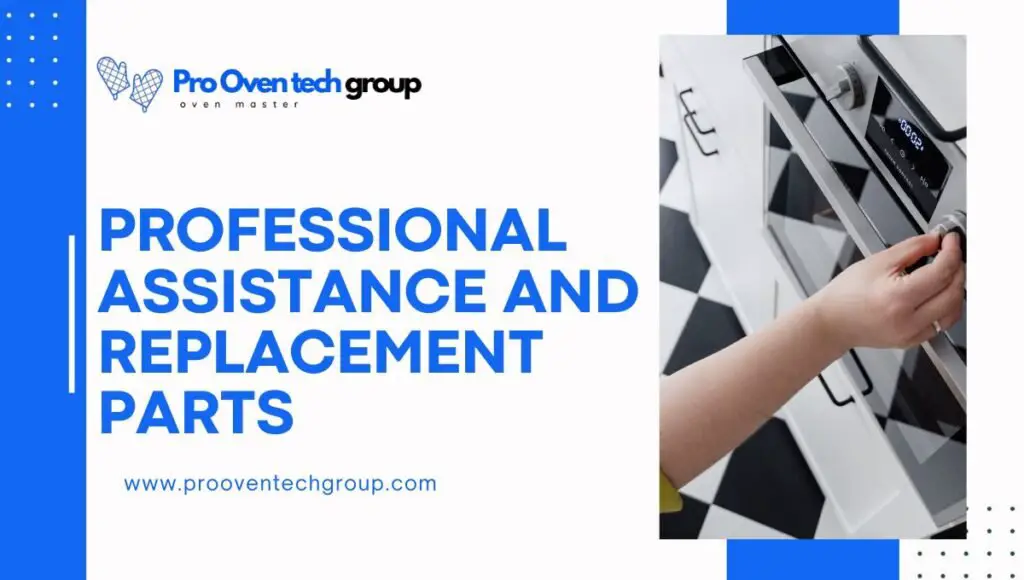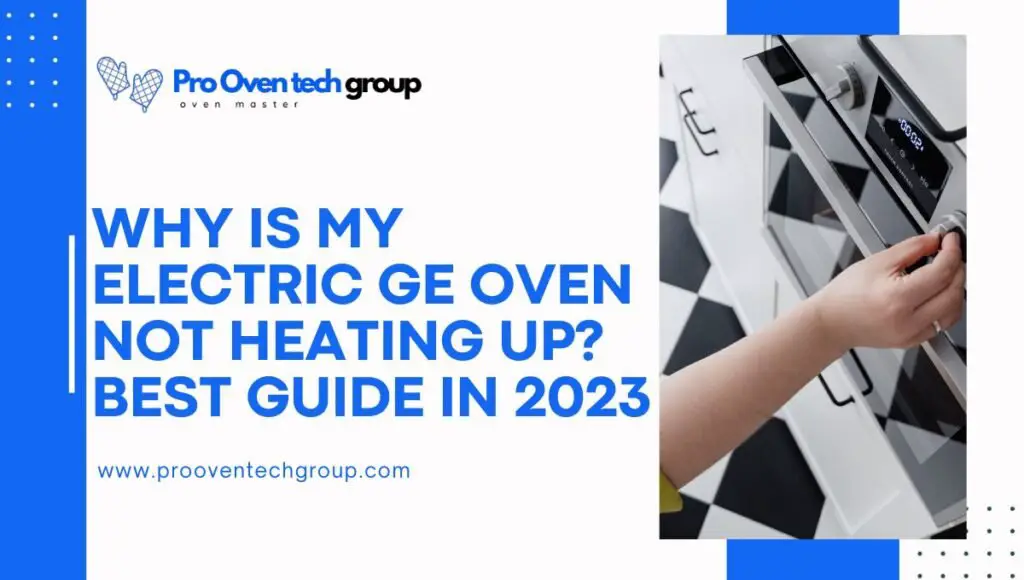Why is my electric ge oven not heating up? Are you the proud owner of a GE oven, only to find that your appliance isn’t heating up like it usually does? If so, you’re probably asking yourself “Why is my electric GE oven not heating up?”
There could be several reasons why your electric GE oven is not heating up. The most common causes include a malfunctioning heating element, a broken thermostat, a faulty oven sensor, or issues with the oven’s control board.
While it can be frustrating when something’s wrong with one of your appliances, by following this step-by-step guide you should have no problem getting back to cooking with ease. With just a few simple tips and troubleshooting techniques, you will soon have your beloved GE oven cooking as good as new.
Table of Contents
Identifying the Problem
To effectively identify the root cause of your GE oven’s heating issue, it’s advisable to check the four most common problem areas: the heating element, the thermostat, the oven sensor, and the oven’s control board. Let’s look into these components individually.
The Heating Element
A defective heating element is often to blame when an oven fails to heat up. Inspect it visually for any signs of damage or burnout. If it doesn’t glow red during the oven’s heating cycle, it may need replacement.
The Thermostat
The thermostat controls the oven’s temperature. If it’s malfunctioning, the oven may not heat correctly or may not heat at all. You can use an oven thermometer to check the thermometer’s accuracy and replace it if necessary.
The Oven Sensor
The oven sensor works in tandem with the thermostat to regulate the oven’s temperature. If it’s defective or has a poor connection, the oven may not heat up. Check it for any sign of damage and replace it if needed.
The Oven’s Control Board
The control board controls the oven’s heating functions. If it’s faulty, it may not send voltage to the heating elements. However, before replacing the control board, check and test the more commonly problematic parts.
Checking the Heating Elements

To check the heating elements of your GE oven, you need to follow certain steps, ensuring you’re carrying out the process safely and effectively. Here’s a detailed guide on how you can perform this task:
- Unplug the Oven: Before you start, make sure the oven is unplugged to avoid any electrical accidents.
- Remove the Racks: Take out the oven racks to have a clear view and access to the heating elements.
- Inspect Visually: Look for any visible signs of damage, such as blisters, holes, or discolouration on the heating elements.
- Check for Resistance: Use a multimeter to check the resistance value of the heating element. A functioning heating element should show a resistance between 20 to 40 ohms.
- Test the Power: Confirm whether power is being supplied to the heating element.
- Replace if Necessary: If there is any damage or the tests show any anomalies, consider replacing the heating element.
- Professional Help: If you are unsure about any part of this process, seek assistance from a professional.
Evaluating the Thermostat
The thermostat is responsible for regulating the oven’s temperature. A faulty thermostat can cause your oven not to heat up. You can test the thermostat to determine if it’s working properly using the following steps:
- Preheat the Oven: Set the oven to any temperature and let it heat for about 15 minutes.
- Check the Temperature: Use an oven thermometer to check the temperature inside the oven.
- Compare the Readings: The reading on the oven and the thermometer should be close. A significant difference indicates a faulty thermostat.
- Adjust the Thermostat: If possible, adjust the thermostat and see if the temperature readings change accordingly.
- Consider Replacement: If the thermostat is not functioning correctly after adjustment, it may need to be replaced.
Inspecting the Oven Sensor
The oven sensor plays a crucial role in maintaining the correct temperature within your oven. When defective, it can cause your oven to fail to heat. Here’s how to check the oven sensor:
- Unplug the Oven: Ensure the oven is unplugged before starting.
- Locate the Sensor: Find the oven sensor, usually located at the back of the oven.
- Check Visually: Look for any visible signs of damage or wear.
- Use a Multimeter: Check the sensor’s resistance. It should be about 1100 ohms at room temperature.
- Consider Replacement: If the sensor shows an incorrect resistance or is visibly damaged, replacement may be necessary.
- Get Professional Help: If unsure, call a professional to assess the sensor.
Reviewing the Control Board
The control board of your GE oven is essentially its brain, coordinating the heating elements’ functions. A malfunctioning control board could cause your oven not to heat up, which is why it’s crucial to assess its condition.
Testing the Control Board
To test the control board, you should check if it’s sending voltage to the heating elements using a multimeter. A lack of voltage would indicate a faulty control board.
Replacement Options
If the control board appears to be faulty, you might need to replace it. This is generally a more complex task, and it’s advised to hire a professional for the job to avoid any errors or potential safety hazards.
Solving Questionable Issues
In some instances, the issue with your GE oven might not be as clear-cut or fall into the common categories. When this happens, it’s important to take a step-by-step approach to isolate the problem. Here are some additional steps to consider:
- Check the Power Supply: Ensure that your oven is receiving adequate power.
- Examine the Wiring: Look for any signs of loose or damaged wires.
- Refer to the Manual: Your oven’s manual might have specific troubleshooting tips.
- Contact GE’s Customer Service: They may provide some insights based on common issues with your specific model.
- Hire a Repair Service: If all else fails, turn to a trusted appliance repair service.
Professional Assistance and Replacement Parts

In certain cases, it may be necessary to seek professional assistance or source replacement parts for your GE oven. This could be due to a complex issue or a need for expertise in handling certain components.
- Professional Repair Services: Engaging a professional service ensures your oven is in skilled hands.
- Manufacturer Support: GE has a robust customer service that can help troubleshoot and arrange professional help.
- OEM Parts: Always opt for Original Equipment Manufacturer (OEM) parts for replacements to maintain quality.
- Warranty Claims: Check your oven’s warranty status as the issue might be covered, saving you costs.
- Preventive Maintenance: Regular servicing by professionals can help prevent future issues.
Conclusion Why is my electric ge oven not heating up
In the end, it’s crucial to understand the reasons why your GE oven may not be heating up and take appropriate action to resolve the issue. By following these steps, you can diagnose and possibly fix the problem yourself or seek professional help if necessary. Remember to always prioritize safety, unplugging the oven before any inspection or repair work. With proper care and maintenance, your GE oven will continue to serve you for many more delicious meals.
FAQS
Q1. GE Profile electric oven not heating up?
A1. Follow the steps outlined in this guide to troubleshoot and fix the issue.
Q2. GE gas oven not heating up but burners work?
A2. This could be due to a faulty heating element or thermostat. Refer to the respective sections in this guide for troubleshooting steps.
Q3. GE electric stove burners and oven not working?
A3. This could be due to a power supply issue or a faulty control board. Refer to the respective sections in this guide for troubleshooting steps.
Q4. How do you reset a GE electric oven?
A4. Locate the oven’s circuit breaker and turn it off for a few minutes before turning it back on. This should reset the oven. If the issue persists, refer to the respective sections in this guide for further troubleshooting steps.
Q5. Why is my GE electric oven not heating up?
A5. Your oven may not be heating up due to various reasons, including a faulty thermostat, sensor, control board, or power supply issue. Refer to this guide for steps on how to troubleshoot and fix the issue. Overall, it’s essential to regularly maintain your GE oven and seek professional help when necessary to ensure it continues functioning at its best.

